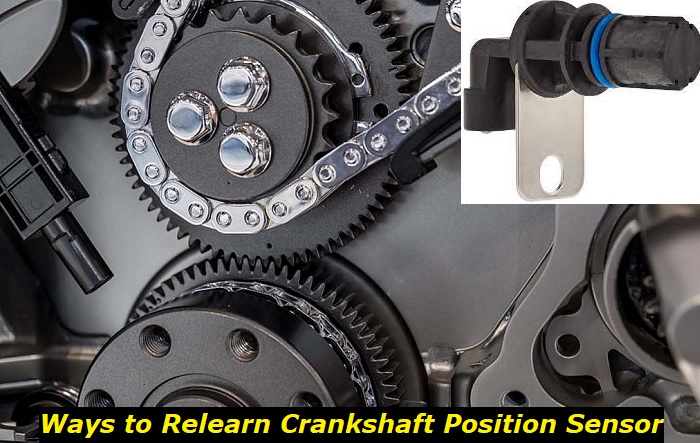The crankshaft is an essential component found on virtually every modern engine. It helps internal combustion engines to function better. The sensor detects the speed and position of the crankshaft and transmits the data to the vehicle's ECU. The Engine Control Module uses this data to adjust accordingly depending on driving conditions.
Engine sensors problems highlights
- DIY repairs:possible
- Tools needed:scanner,basictools
- Commonreasons:sensor problems, electric supply issues, software glitches
- Time to repair:1 - 2.5 hours
- Price for parts:$50 - $250
- Can you drive?In most cases, yes
- Alternative solutions:bypassing, driving in limp mode, roadside assistance

How to Relearn Crankshaft Position Sensor without Scanner
Performing a reset is the most optimal solution for a problematic crankshaft position sensor. When you reinstall the sensor, you may encounter some severe difficulties. The magnetic sensor receives a transmission from every crank of a revolution. If you have a modern vehicle, your computer system simultaneously compares this data with the database. The two sets of data must synchronize for your car to function.
If the ECU senses a lack of synchronization, it cuts off the power supply, thus rendering your vehicle immobile. The power limitation is a safety feature to protect your engine from further damage.
So, How Do You Bypass These Issues?
The best way to beat these problems is by removing the old crankshaft position sensor, replacing it with a new one, and resetting the system. When you do this, the reset will erase all the previous trouble codes and synchronize the data.
Steps To Relearn Your Crankshaft Position Sensor without Scanner:
- Start by turning off your vehicle accessories and putting your air sensor and coolant level 5C apart. Start the engine.
- Leave the engine in neutral for two minutes.
- Accelerate to 55 mph and remain at this speed for 10 minutes for the engine to attain its ideal operating temperature.
- Maintain this speed for another 50 seconds, and reduce it to 45 mph.
- Maintain 45 mph for two minutes.
- Perform four deceleration cycles of 25 seconds each by returning to 45 mph every 15 seconds. These decelerations have no specific speed limits. Moreover, you cannot use the brakes during these cycles.
- Press the gas pedal to 55 mph, and remain there for another two minutes.
- Stop the vehicle and engage the brakes. Do not put it in neutral. If you have a manual transmission vehicle, leave it in gear and press the clutch pedal. Leave the engine at idle for two minutes.
You have completed the relearning process of your crankshaft position sensor.
What If I Disconnect My Battery? Will It Reset the Crankshaft Position Sensor?
Although this may sound extreme, disconnecting the battery is a shortcut to resetting your crankshaft position sensor. This will work when you are not replacing or repairing the sensor itself.
This method works because disconnecting the battery clears all fault codes stored in the ECU system. As a result, when you reconnect the battery, the system will not have any problem synchronizing since there is no contradicting data.
Important to note is that while this method may solve the issue and get you back on the road, you may need to visit a mechanic to check and determine what initially caused the sensor to fail. Shortcut solutions do not last long.
Always check to ensure you have securely reconnected the battery before starting and driving your vehicle.
When Should I Relearn My Crankshaft Position Sensor?
You should reset the crankshaft position sensor every time you install a new unit. Relearning the sensor removes previous trouble codes in the system and allows it to synchronize and transmit reliable data. Not resetting the system can cause troubles such as engine backfiring, hard or failed start, and other problems.
Most of these problems will result in reduced engine power and poor performance.
Symptoms of a Faulty Crankshaft Position Sensor
A failing crankshaft position sensor will mostly manifest one of the following symptoms.
1) Difficulty Starting the Car
The primary sign of a failing crankshaft position sensor is difficulties igniting your vehicle. The sensor monitors some of the most critical parameters of starting a car. Such parameters include the rotational speed and position of the crankshaft.
When the sensor fails and transmits incorrect data, the Engine Control Unit automatically cuts off the power supply to protect the engine from further damage. When this happens, you may have difficulty starting the car, or it may not start.
2) Engine Misfire
Another sign of a failing crankshaft position sensor is the engine misfiring and vibrating. The stuttering behavior is a sign of misfiring cylinders caused by a failed crankshaft position sensor. This happens because the sensor cannot provide accurate data about the position of the piston in the engine. If you have an engine misfiring, you can start by checking the spark plugs. If they check out, then you have a faulty crankshaft position sensor.
3) Rough Idle
A bad crankshaft position sensor will cause your engine to experience rough idling. You will notice the engine grinding and vibrating when you stop at a red light or during slow traffic. This means the sensor is not monitoring the crankshaft position properly, which may affect the overall engine power production and performance.
A vibrating engine may also interfere with the tracking of mileage. If you notice any strange shaking or vibration, have a mechanic inspect it immediately to avoid further damage.
4) Poor Gas Mileage
Lack of accurate monitoring of the crankshaft position makes it difficult for the fuel injectors to function efficiently. The engine may consume more fuel than it requires on short or long drives, affecting the overall gas mileage. If you notice you are spending more on fuel than usual, have a professional mechanic diagnose your vehicle.
5) Uneven Acceleration
If the crankshaft position sensor provides inaccurate data to the ECU, it may not accurately adjust the spark plug and fuel injector timing as you accelerate. Uneven acceleration makes it challenging to maintain a certain speed. Have a mechanic check the crankshaft position sensor.
Other symptoms of a bad crankshaft position sensor include check engine light illuminating, intermittent engine stalling, and poor engine performance.
Is It Okay to Drive with a Faulty Crankshaft Position Sensor?
Forget safe! It might not even be possible to drive your vehicle if it has a faulty crankshaft position sensor. It is dangerous, and no professional mechanic would recommend it. You should worry about what could happen to your engine if you drive with a faulty crankshaft position sensor. It could lead to problems that can cause your vehicle to break down.
One of the common signs of a faulty crankshaft position sensor is excessive fuel consumption. If you keep driving before resolving the problem, you may spend more money on fuel than you should.
A bad crankshaft position sensor may also cause rough idling and engine vibrations. If you do not resolve the problem sooner, the vibrations can further damage the engine.
Driving with a stalling engine is dangerous to you and other road users. Sudden stops in the middle of the road put you at risk of accidents. The best option is to fix the faulty crankshaft position sensor by replacing or repairing it.
Conclusion
The crankshaft position sensor is an essential part of the engine. It provides the ECU with signals vital for the functionality of the engine. A faulty crankshaft position sensor can quickly cause a series of problems that significantly affect the performance of your engine, which is why you should inspect it when you suspect a problem with the sensor.
Relearning the crankshaft position sensor will restore your engine to its proper state. The good news is that you do not need an OBDII scanner to do it. Following the steps we highlighted earlier, you can reset your crankshaft position sensor and be on the road. You will only need a sound mind so that you do not leave out any step of the process.
About the authors
The CarAraC research team is composed of seasoned auto mechanics and automotive industry professionals, including individuals with advanced degrees and certifications in their field. Our team members boast prestigious credentials, reflecting their extensive knowledge and skills. These qualifications include: IMI: Institute of the Motor Industry, ASE-Certified Master Automobile Technicians; Coventry University, Graduate of MA in Automotive Journalism; Politecnico di Torino, Italy, MS Automotive Engineering; Ss. Cyril and Methodius University in Skopje, Mechanical University in Skopje; TOC Automotive College; DHA Suffa University, Department of Mechanical Engineering





Add comment